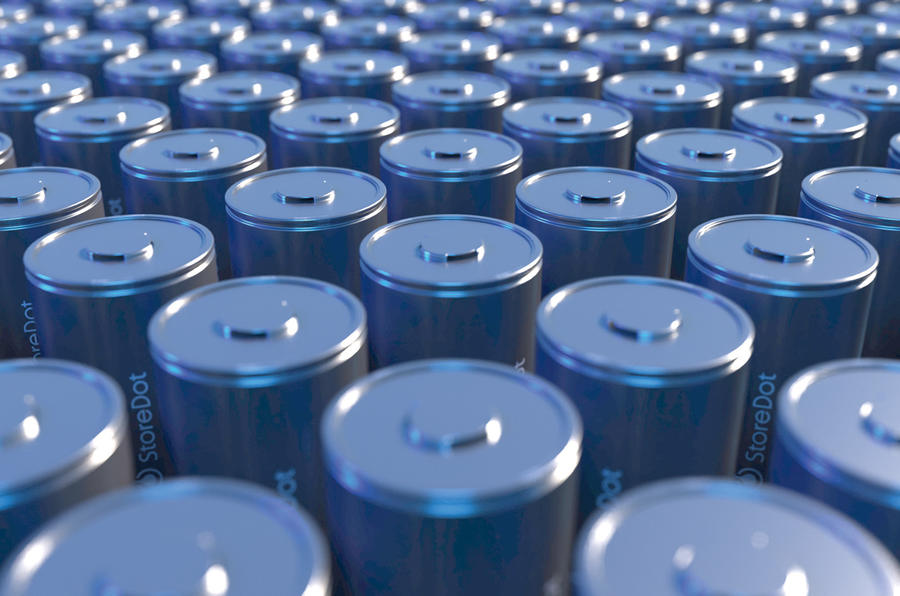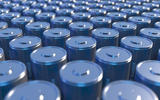Israeli company storedot, which numbers Daimler, Samsung and BP Ventures among its investors, claims to be the first to have produced extreme fast charge (XFC) lithium ion battery cells on a mass-production line. The cells, based on silicon-dominant anodes, are said to reduce charge time by 50% with no increase in cost.
Silicon, as a replacement for graphite to store and release lithium ions during charge and discharge, is the big thing in battery technology today, but making it work isn’t easy. It can store about 10 times more lithium ions than graphite and allows much faster charging: that much is well known. The problem is that during charging and discharging, it changes volume by as much as 300%, which is enough to mechanically destroy a cell.
One solution is to use nano particles of silicon held in a matrix, which makes it possible to manage the expansion with no detrimental effects. That is what Storedot claims to have done. Each nano particle of silicon, measuring only 100 nanometres across, is held within a scaffold of hard carbon and organic compounds. Unlike graphite, which plays an active role in the charge and discharge cycle, the scaffold is inactive and each miniature golf ball of silicon has enough room to move thanks to elasticity in the scaffold as it receives and gives up its charge. Overall, this reduces the expansion to a manageable 10%.
Storedot has also patented a ‘self-healing’ technology to seamlessly repair individual damaged cells in the background. It identifies a cell or string of cells that are not performing as they should or are overheating, takes them offline and reconditions them back to 100% before bringing them back on line. The process is designed to happen during use and without the driver noticing any difference to driving or performance.
Repair of the affected cells consists of a deep, slow discharge and equally slow recharge in much the same way as a conventional car battery might be rejuvenated using a specialised smart charger. All lithium ion battery anodes form a coating on the surface of the anode called a solid electrolyte interface (SEI – nothing to do with solid-state batteries), which forms and dissolves during charge and discharge. The repair process is especially important for silicon-dominant technology because the expansion and contraction can cause cracks in the SEI, so unless checked, it would continually reform, consuming lithium in the process and ageing the battery.
Storedot attributes its rapid progress partly to the development of AI software, which analyses every morsel of available information relating to the use of silicon in lithium ion batteries. So far, it has achieved the goal of being able to mass-produce silicon-dominant cells that can withstand extreme fast charging over 850 consecutive 10-minute cycles and retain 80% capacity, and it has a 10% expansion rate and a capacity of 300Wh/kg (compared with around 140Wh/kg for a typical production 64kWh battery today). The new XFC technology with self-healing capability will be in production by 2024, followed by solid-state technology in 2028.






 Hydrogen could literally take off in a big way by powering jet airliners during the next decade. The government-backed Fly Zero project team recently announced that hydrogen-powered airliners could fly as far as London to San Francisco without refuelling from around 2035 onwards. The aircraft will store liquid hydrogen at the rear of the fuselage and in blister tanks at the front, powering hydrogen turbine engines and fuel cells for electrical power.
Hydrogen could literally take off in a big way by powering jet airliners during the next decade. The government-backed Fly Zero project team recently announced that hydrogen-powered airliners could fly as far as London to San Francisco without refuelling from around 2035 onwards. The aircraft will store liquid hydrogen at the rear of the fuselage and in blister tanks at the front, powering hydrogen turbine engines and fuel cells for electrical power.

Join the debate
Add your comment
With this and similar refinements to the basic lithium ion technology currently being researched, perhaps the much awaited solid state battery won't be such an advance after all.